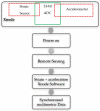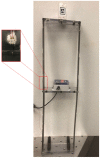Development and Validation of a Framework for Smart Wireless Strain and Acceleration Sensing
- PMID: 35271144
- PMCID: PMC8914880
- DOI: 10.3390/s22051998
Development and Validation of a Framework for Smart Wireless Strain and Acceleration Sensing
Abstract
Civil infrastructure worldwide is subject to factors such as aging and deterioration. Structural health monitoring (SHM) can be used to assess the impact of these processes on structural performance. SHM demands have evolved from routine monitoring to real-time and autonomous assessment. One of the frontiers in achieving effective SHM systems has been the use of wireless smart sensors (WSSs), which are attractive compared to wired sensors, due to their flexibility of use, lower costs, and ease of long-term deployment. Most WSSs use accelerometers to collect global dynamic vibration data. However, obtaining local behaviors in a structure using measurands such as strain may also be desirable. While wireless strain sensors have previously been developed by some researchers, there is still a need for a high sensitivity wireless strain sensor that fully meets the general demands for monitoring large-scale civil infrastructure. In this paper, a framework for synchronized wireless high-fidelity acceleration and strain sensing, which is commonly termed multimetric sensing in the literature, is proposed. The framework is implemented on the Xnode, a next-generation wireless smart sensor platform, and integrates with the strain sensor for strain acquisition. An application of the multimetric sensing framework is illustrated for total displacement estimation. Finally, the potential of the proposed framework integrated with vision-based measurement systems for multi-point displacement estimation with camera-motion compensation is demonstrated. The proposed approach is verified experimentally, showing the potential of the developed framework for various SHM applications.
Keywords: framework; multimetric sensing; strain sensor; structural health monitoring; wireless smart sensor.
Conflict of interest statement
The authors declare no conflict of interest.
Figures















Similar articles
-
Development of a High-Sensitivity Wireless Accelerometer for Structural Health Monitoring.Sensors (Basel). 2018 Jan 17;18(1):262. doi: 10.3390/s18010262. Sensors (Basel). 2018. PMID: 29342102 Free PMC article.
-
Development of Synchronized High-Sensitivity Wireless Accelerometer for Structural Health Monitoring.Sensors (Basel). 2020 Jul 27;20(15):4169. doi: 10.3390/s20154169. Sensors (Basel). 2020. PMID: 32727037 Free PMC article.
-
Structural Health Monitoring of Fatigue Cracks for Steel Bridges with Wireless Large-Area Strain Sensors.Sensors (Basel). 2022 Jul 6;22(14):5076. doi: 10.3390/s22145076. Sensors (Basel). 2022. PMID: 35890756 Free PMC article.
-
Concise Historic Overview of Strain Sensors Used in the Monitoring of Civil Structures: The First One Hundred Years.Sensors (Basel). 2022 Mar 20;22(6):2397. doi: 10.3390/s22062397. Sensors (Basel). 2022. PMID: 35336568 Free PMC article. Review.
-
Review of Wireless RFID Strain Sensing Technology in Structural Health Monitoring.Sensors (Basel). 2023 Aug 3;23(15):6925. doi: 10.3390/s23156925. Sensors (Basel). 2023. PMID: 37571708 Free PMC article. Review.
Cited by
-
Edge Integration of Artificial Intelligence into Wireless Smart Sensor Platforms for Railroad Bridge Impact Detection.Sensors (Basel). 2024 Aug 30;24(17):5633. doi: 10.3390/s24175633. Sensors (Basel). 2024. PMID: 39275541 Free PMC article.
-
A Systematic Review of Optimization Algorithms for Structural Health Monitoring and Optimal Sensor Placement.Sensors (Basel). 2023 Mar 20;23(6):3293. doi: 10.3390/s23063293. Sensors (Basel). 2023. PMID: 36992004 Free PMC article. Review.
-
Buildings' Biaxial Tilt Assessment Using Inertial Wireless Sensors and a Parallel Training Model.Sensors (Basel). 2023 Jun 5;23(11):5352. doi: 10.3390/s23115352. Sensors (Basel). 2023. PMID: 37300079 Free PMC article.
-
3D Measurement of Large Deformations on a Tensile Structure during Wind Tunnel Tests Using Microsoft Kinect V2.Sensors (Basel). 2022 Aug 17;22(16):6149. doi: 10.3390/s22166149. Sensors (Basel). 2022. PMID: 36015911 Free PMC article.
References
-
- Investigation of 15 March 2018 Pedestrian Bridge Collapse at Florida International University, Miami, FL, USA. [(accessed on 9 September 2021)]; Available online: https://www.osha.gov/doc/engineering/pdf/2019_r_03.pdf.
-
- Kallergis K., Dinkova L. Engineer Raised Red Flags More than 2 Years before Surfside Condo Collapsed. [(accessed on 9 September 2021)]. Available online: https://therealdeal.com/miami/2021/06/26/engineer-raised-red-flags-more-...
-
- Hotel Collapse in China’s Suzhou Kills 17, Injures Five—BBC News. [(accessed on 25 September 2021)]. Available online: https://www.bbc.com/news/world-asia-china-57830767.
-
- Death Toll from Cairo Building Collapse up to 25 after Two Bodies Recovered-Politics-Egypt-Ahram Online. [(accessed on 25 September 2021)]. Available online: https://english.ahram.org.eg/NewsContent/1/64/407944/Egypt/Politics-/Dea....
-
- Alam N., Shajib K.A.S., Mamun M.A. Bridge Health Monitoring System; Proceedings of the IABSE-JSCE Joint Conference on Advances in Bridge Engineering-IV; Dhaka, Bangladesh. 26–27 August 2020.
MeSH terms
Grants and funding
LinkOut - more resources
Full Text Sources

